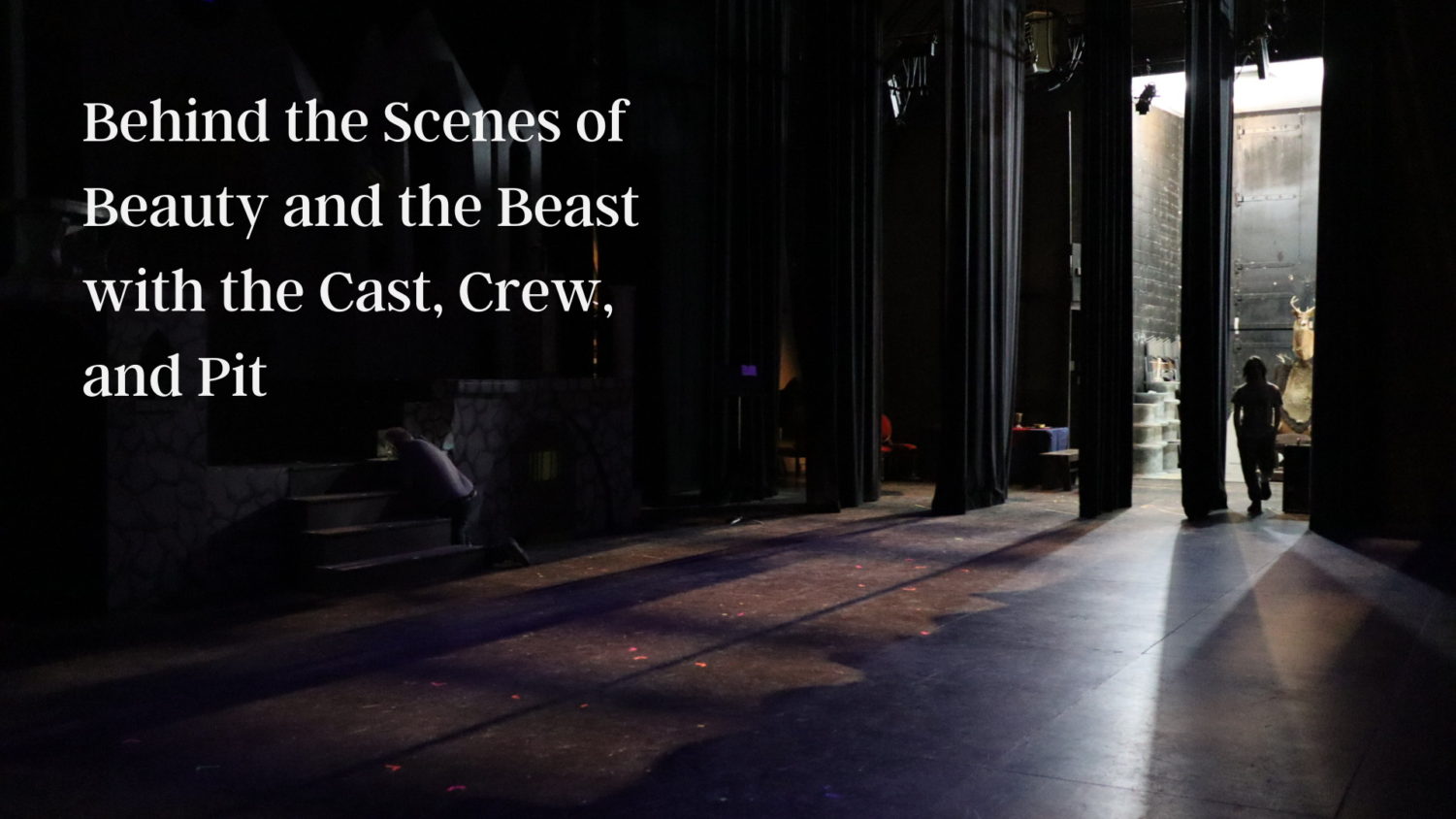The Tosa Compass is the only dedicated Wauwatosa newspaper, providing quality news coverage. Your donation will support the student journalists of Wauwatosa East and West, helping us purchase equipment and cover our annual website hosting costs.
Behind the Scenes of Beauty and the Beast with the Cast, Crew, and Pit
It takes well over 100 students to put on a Trojan Players production. Students perform on the stage, play music in the pit, build complex sets, and so much more. Go behind the scenes to find out how the cast, crew, and pit put together an award-winning production.
March 4, 2022

Students practice in pit.
Behind the Scenes with the Pit
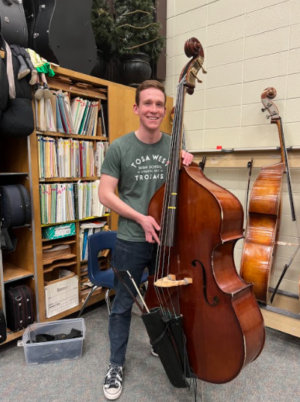
“I do enjoy playing in the pit. It is one of my favorite parts about being involved with music at West. It allows me to grow as a musician because of the different music types and settings. Also, sitting in the actual pit in a show kinda relieves the stress from it, since you aren’t seen by the audience,” said Tosa West junior, Ethan Espinosa, who plays bass.
17 Tosa West students are part of the pit orchestra. It is a set of live musicians sitting under the stage working together under the direction of a conductor to make the live musical experience unique, exciting, and more full.
“We all wear headsets so it is easy for Mr.Hunt to communicate with us. It does get really cramped down there and hard to walk around when all of the people, equipment, and instruments are down there, but it is worth it,” said Tosa West junior, Abigail Burgardt, who’s plays the trumpet.
The pit is led by band director, Alexander Hunt and Orchestra teacher, Tiffany Chang.
“I help to select student musicians, contract the adult musicians, make the rehearsal schedules, and take care of communication,” said Hunt.
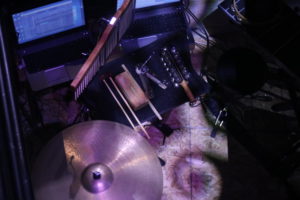
Although their roles are different, they’re both vital to the success of the pit.
“I help all of the student string players involved. There are a number of techniques that the string players have come across in their school music at other points in time, but this musical has a very high concentration of all of these techniques all happening in close proximity,” said Chang.
Becoming a part of the pit is a process that differs for orchestra and band students.
“Mrs. Chang held auditions for the string instruments, but band kids were asked to play in it, so you have to be one of the best musicians in the school in order to be a part of it,” said Tosa West Senior, Ella Schimabauer, who plays the keyboard.
The musicians for Beauty and the Beast had to learn 24 songs, which equates to two hours show’s worth of music, an overture before the musical starts, and music after the show is over for bows, and they have to know it all at a professional level.
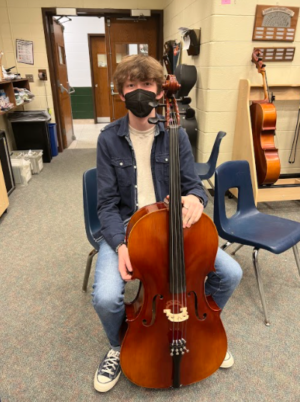
“The music is fairly difficult because we are playing with vocalists, we have to play in a key signature that is comfortable for someone singing, but not necessarily “friendly” for us. Keeping track of 7 flats or 7 sharps or double sharps or double flats is hard. There are also many tricky transitions out of vamps when we are waiting for dialogue to happen, or tempo changes necessary for dancing on stage. It also takes a large amount of concentration to stay focused for many hours at a time,” said Chang.
Independent learning is very important, considering the length of the books of music, and the inability to go through it all and teach it to each individual musician. Students have to be able to read accurately, adapt quickly, and be open to feedback.
“I try to spend at least an hour or two a week practicing outside of rehearsal. I don’t have a ton of free time so it’s hard to find time, but I get it where I can,” said Tosa West junior, Noah Kubiak.
Learning the music is one part, but then having to adapt for the actors on stage presents another issue.
“Pit music, at least for me, isn’t very hard, but the challenge comes from the queues and paying attention to the singers, which can’t be practiced outside of school,” said Espinosa.
However the challenge that comes from adjusting for actors, is what makes the live music all that much better.
“I lead them, by conducting, and we can make real time adjustments to perfectly match the actors on stage. Also, live music sounds better than something that is pre recorded. There is more variety in the tone color of sound,” said Hunt.
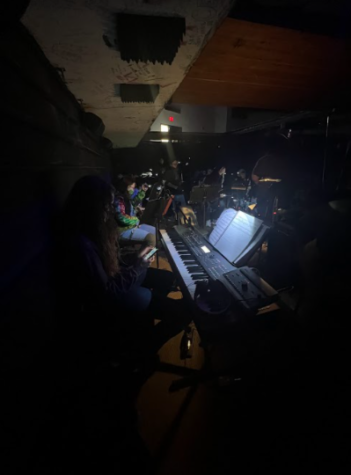
The pit adds a whole new layer to the musical, yet many feel a lack of appreciation.
“When people are congratulating the theater program for a show, they’ll say congratulations only to the cast and crew. We put in just as much work as the cast and crew. It’s not like just anyone can do pit either. Anyone can walk into a cast audition or join the crew with no experience and do perfectly fine, but that’s not the case for pit,” said Schimabauer..
The same feelings are felt by other musicians in the pit.
“Within the preparation for the show, many posts are made about the cast and tech and how they are getting ready, but out of this whole year (42nd street and Beauty and the Beast) there was only one post about pit preparation, and it was combined with the cast and crew. I feel like there are many ways we could get more recognition, they are just not being done,” Burgardt pointed out.
“I feel like a lot of times, people who come to the shows wouldn’t even know we existed if they didn’t see a giant hole in the stage and the conductor’s head poking out,” added Schimabauer.
However, others believe the opposite.
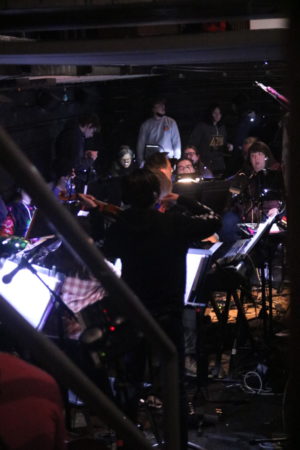
“I think the pit gets a good amount of recognition. We get motioned to in the bows, and we are listed in the program,” said Kubiak.
Regardless of their stance on the amount of recognition they deserve, all musicians in the pit find it enjoyable.
“I love being part of the pit. Theater and band are the two things that I most love being a part of, so being able to combine the two is perfect for me. I do want to continue to play in the pit next year if that experience arises again,” said Burghardt.
Similar sentiments are felt by a majority of the musicians.
“This is my first time doing pit and so far it’s been a lot of fun. We all understand that the music is hard and it’s fun learning it all together. I would definitely do it next year, if it requires string parts,” said Kubiak.
Both students and staff believe that the pit is an important aspect of the show.
“Imagine the show with no pit orchestra playing. It would be empty, and awkward. Maurice prowling around the castle without the underscoring would be very strange. None of the songs are designed to be sung acapella. The dancers need music to keep a tempo. The key word in “musical” is “music,” said Chang.
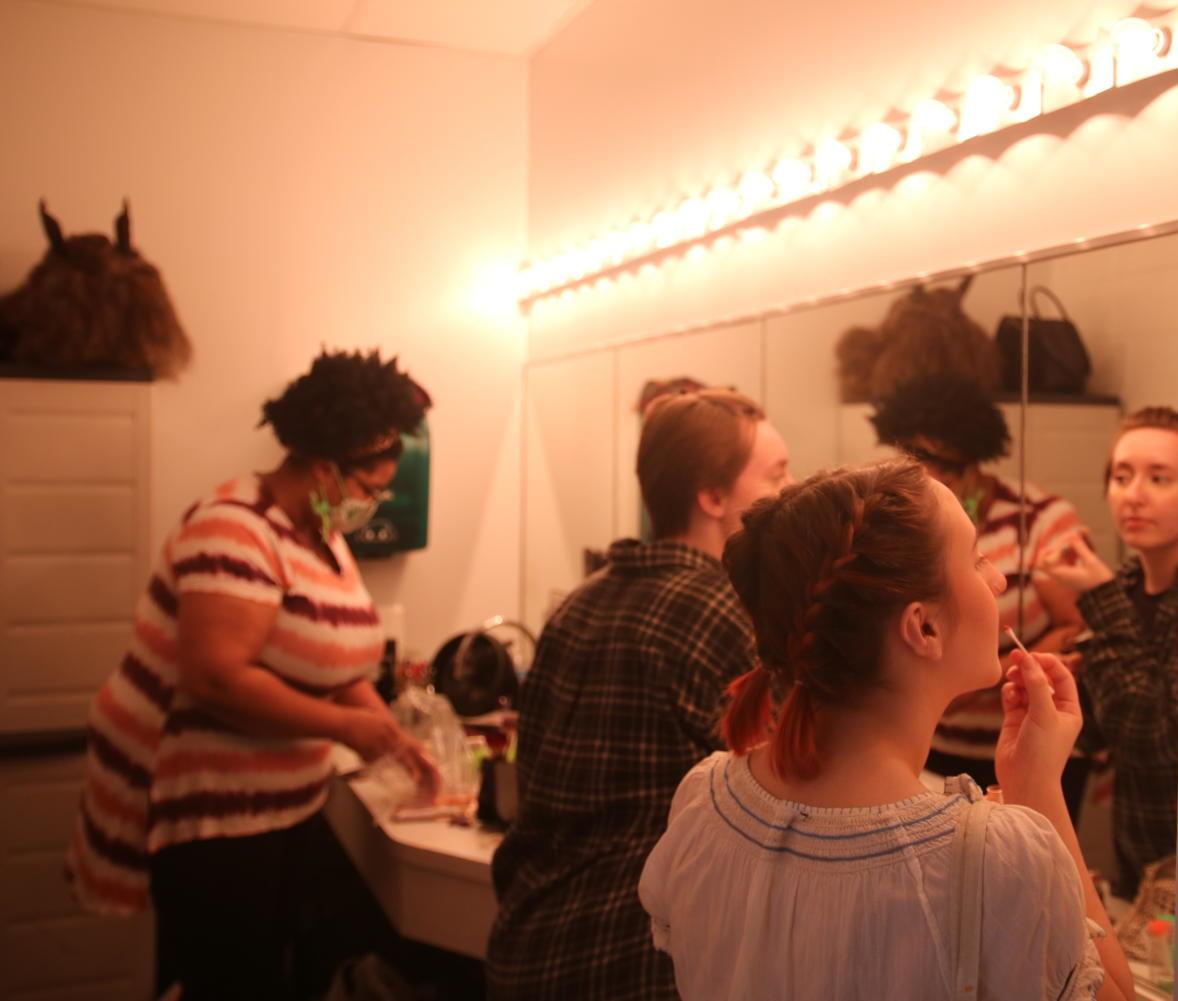
Actors putting on makeup.
Behind the Scenes with the Cast
Wauwatosa West Theater presents their spring production of “Beauty and the Beast” on opening night, Friday, March 4th. Actors in the production are excited for their hard work to be shown on the stage, but the most important part of theater for many is the welcoming community off of it.
“The community that the theater has is really fun to be a part of, and we’re all super motivated towards a common goal and we just have a lot of fun together,” says Andrea Justin, Senior, who plays Napkin and Wolf.
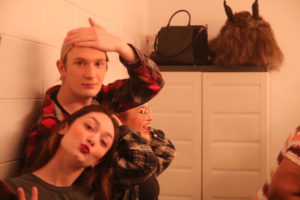
The large time commitment of theater means that actors are able to spend a lot of time together.
“I really like the community. Everybody’s so welcoming. And in three months, you basically become a family and you get to create just amazing performances together,” concurs Sophomore Sawyer Vespalec, an ensemble member.
While the program focuses on drama, it also is a great place for actors to make new friends and socialize.
“My favorite part is the friendships you can make behind the scenes. While I’m doing the process of theater and rehearsing, I like making those friends and then doing all those things outside of the theater, like going to dinner after,” says senior and dance captain Payton Raue.
She thinks that theater has helped her with public speaking skills and perseverance.
“It’s definitely made getting in front of a group and presenting something a lot easier just because if I can sing and dance in front of hundreds of people, I can give a presentation in class. And then perseverance can help you learn to keep trying your best for everything that you do. Because you might not get a part that you want after an audition, but you can still keep working at it, and there’s definitely a lot of room to grow,” says Raue.
Theater can help actors build confidence outside of the stage, and learn how to get past worries.
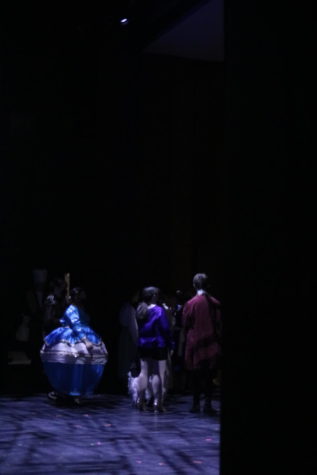
“Even if you’re scared or worried or nervous, it’s totally worth taking risks. It’s an essential part of learning and developing,” says Senior Steven Peterson.
Peterson had never done theater at West before and now plays one of the lead roles of Gaston.
“I’ve never done this before. Like it was a little scary. I was not expecting a lead, and it was kind of surprising just being thrown into something that I’ve never done before,” says Peterson.
Preparation for the show comes with many challenges. Actors need to memorize their lines, their cues, and learn how to perform. One of the largest obstacles is the time commitment.
“Tech Week is really a lot. It’s seven hour rehearsals every day, and you’re just constantly practicing the same thing so it can get really frustrating when it doesn’t go right,” says Justin. “But it’s necessary for the final product.”
Tech Week is the week leading up to opening night. Students on run crew and cast rehearse the play and go through dance sequences. Practices can often last until 10 pm. This can take a toll on students because of how time consuming it is paired with school, especially regarding sleep.
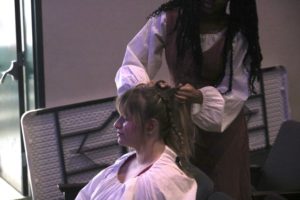
“I think the most challenging part of theater is Tech Week because we’re there from school till 10pm. And then I have to do it every day of the week,” says Senior and villager in the production, Georgia Makal. “So I’ll be singing and I’ll be so tired that all of a sudden I can’t remember the words, but I still have to do it well, because I’m preparing for the show.”
Despite the challenges that come with theater, the cast is excited for the show.
“I just want theater to keep going how it is here. It’s so amazing that I can’t really think of any way to improve it,” says Vespalec.

Crew sits around pit.
Behind the Scenes with Tech Crew
“Watching the show finally come together during tech week is really cool. To see all of the work that tech has been doing combined with all of the work the actors and actresses have been doing,” said Senior Ella Schwantes.
Tosa West’s theater “tech crew” is in charge of building the sets and props for the show, and have been working for weeks after school, prepping for opening night. Tech crew is directed and coordinated by Tosa West parent and Milwaukee Area Technical College theater specialist Dale Schively.
“We worked forever to cross brace on the top one of the tallest platforms on the castle. And that one looks really good now and it doesn’t fall over. So that’s always a plus,” said Freshman Caroline Henzig.
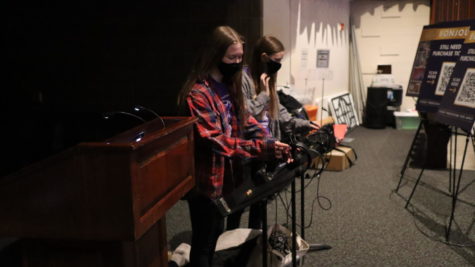
The final week of production and practice is called “tech week”. Tech week is the most chaotic week leading up to opening night.The cast and crew run through the show and add finishing touches to sets and tasks in preparation for the curtain to rise on Friday night.
“Energy is high, as it should be. You have to hype yourself up, and make sure everybody is working as hard as they can to make the show go as smoothly as possible,” said Schwantes.
During tech week, the entire cast and crew will stay until 9 or 10 at night to rehearse before opening night. It is time consuming and exhausting, but everyone is excited and ready for the challenge.
“I think everyone is collectively ready, but also preparing for the exhaustion that is going to come,” said Junior Gillian Frey.
Tech week is helpful for tech crew, the cast, and the pit. It helps everyone get prepared and become confident before performing on opening night. The chaos of tech week is also a time for team building and new friendships.
“It’s really fun to see the improvement we’ve made everyday, and this is the time where we become a family as a theater group,” said Senior Amira Makhlouf.
All of tech crew has been very excited about both tech week and opening night, and are prepared for their upcoming performances.

